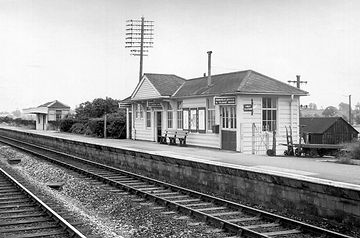Stoke St Gregory History Pages
Road & Rail
Railway
Our railway was built to connect the main line with Yeovil. It opened in 1853 using the broad gauge. At that time the route between London and Taunton was via Bath and Bridgwater, but a more direct route was formed through Athelney.
Read more HERE

Athelney Station Waiting Room on 13th June 1964, the last day of passenger services from Taunton to Yeovil.
Photo courtesy of Michael L. Roach ©
Roads
The neolithic timber causeways known as the the Post Track and the Sweet Track are not many miles from Stoke, and the soil of West Sedgemoor may well hide similar early roads, but the peat in this area has not been subject to the same excavations as in the Brue valley, so we may never know for certain. Later road systems served the village for local horse transport and occasional trips to the market towns of Taunton, Bridgwater and Langport, but were never part of the turnpike system. Stoke was in the middle of the turnpike triangle of Taunton, Othery and Langport, so has always been somewhat isolated.
Within the parish, it is recorded that some roads were dug out by hand to form easier gradients to move wagon loads up the hills. This became more important as the moors were drained and were able to support crops of hay. New roads were created when the final enclosures took place, including Woodhill, which was the boundary of the old Woodhill Green common, and the road through Meare Green, also originally a common.
Until 1945, the old parish of Stoke contained the last remaining toll bridge. Read more HERE
Droves
The droves of Stoke are not what people would recognise as drovers' roads, winding across large tracts of Britain. They were all built or laid down to provide access to parcels of agricultural land within the village. Early ones would have led from the village to the common lands on the low lying moorland, where there was some summer grazing. When the moors were enclosed and the land was divided into fields by 'wet hedges' - ditches and rhynes - the new droves provided access for the owners of each new plot of land.

An Unsurfaced Curload Hill

Tractor Meets Cart on Pincombe Drove